Carlisle, Cumberland
Up to 1834
A parliamentary report of 1777 recorded local workhouses in the Carlisle parishes of St Cuthbert's (one serving the Botherby, Botchergate & Carleton Quarters for up to 12 inmates; another serving Briscoe, Harraby & Upperby Quarters for 7 inmates), St Mary's—Caldewgate Quarter (20 inmates), and St Mary's—Rickergate Quarter (10 inmates). Workhouses were also listed at Rockcliffe—Castle Town Quarter (8 inmates), Rockcliffe—Church Town Quarter (8), Stapleton—Stanwix Quarter (2), and Weathereal Parish (12).
Carlisle St Mary's erected a new workhouse in 1784 on Devonshire Walk. A Cumberland directory of 1847 described this as "a large building with a spacious yard adjoining". This is probably the establishment described by Eden in his 1797 survey of the poor in England:
In 1809, St Cuthbert's parish erected a workhouse which was known as Harraby Hill House at a cost of about £4,000 including furniture etc. It was a large square stone building, stands on an acre of ground, which was purchased many years earlier with a bequest of £20 and money from the parish.
Caldewgate parish followed with a workhouse on Coal-fell Hill, Belle Vue, built in 1829-30 at a cost of £750. It was a plain brick structure and was extended in the 1840s to accommodate 130 inmates.
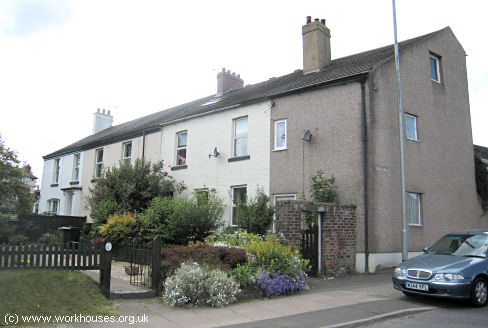
The former Caldewgate workhouse, 2009.
© Peter Higginbotham.
The parish of Dalston erected a workhouse in 1827 about a mile to the south of Dalston village. The building was designed by Thomas Martin of Dalston. According to an 1829 directory, it was built "on an allotment granted for that purpose by the Commissioners, at the enclosure of the commons in 1803. It is a large and convenient structure, with offices for the use of the Select Vestry, and cost about £500 which was raised by a rate levied on the parishioners. In November, 1828, it contained only 17 inmates."
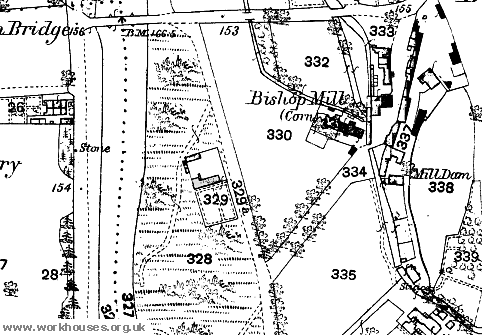
Dalston former workhouse site (plot 329), 1862.
The parishes of Warwick and Wetheral (sometimes spelled Wetherall) operated a joint workhouse on Holme Lane, to the west of Aglionby.
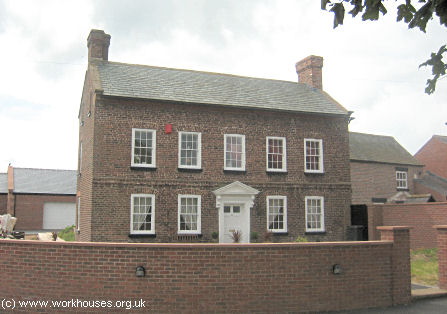
The former Wetheral workhouse, 2009.
© Peter Higginbotham.
After 1834
The new Carlisle Poor law Union formally came into being on 2nd May 1838. Its operation was overseen by an elected Board of Guardians, 25 in number, representing its 19 constituent parishes and townships as listed below (figures in brackets indicate numbers of Guardians where not one):
Cumberland:
Beaumont, Burgh-by-Sands, Carlisle—St Mary's Rickersgate (2), Carlisle—St Mary's Caldewgate (2), Carlisle—St Mary's Cummersdale, Crosby-on-Eden, Dalston (2), Grinsdale, Kirkandrew's-on-Eden, Kingmoor, Orton, Rockcliffe, Stanwix, St Cuthbert's-within-Carlisle (2), St Cuthbert's-without-Carlisle (2), Warwick and Aglionby, Weatherall (2), Wreay.
Later Additions: Belle Vue (from 1894), Botchergate (1894-1904), Eaglesfield Abbey (1862-1904).
The population falling within the union at the 1831 census had been 35,027 with parishes and townships ranging in size from Kirkandrew's-on-Eden (population 107) to Carlisle St Cuthert's (9,449). The average annual poor-rate expenditure for the period 1834-36 had been £5,752 or 3s.3d. per head of the population.
The new union retained the existing parish workhouses with St Cuthbert's at Harraby Hill being used to accommodate children, St Mary's being used for the infirm, and Caldewgate for able-bodied paupers
Like many other northern manufacturing areas, Carlisle found it difficult to operate the "workhouse or nothing" principle of relief enshrined in the 1834 Poor Law Amendment Act. In 1839 and 1840, slumps in the local textile trade could lead to 450 handloom weavers suddenly in need of relief. This was more than the workhouse could cope with and would anyway have been very expensive for the Union - the cost of keeping someone in the workhouse was much more than giving them modest out-relief as either food, or as a small cash payment. The weavers themselves were far from being totally destitute. What they wanted was short term relief which would allow them to continue with what little employment there was until times gradually improved.
In response to this dilemma, the Poor Law Commission allowed the Carlisle Guardians to operate an "outdoor labour test". This allowed the giving of relief to the able-bodied so long as they were prepared to undertake hard manual labour such as stone-breaking in a specially set up labour yard. Few were prepared to take this option and tried to scrape by as best they could. The plight of the weavers led to the setting up of charitable "relief committees" funded by local citizens.
The Fusehill Street Workhouse
In 1863, the union erected a new purpose-built workhouse on Fusehill Street in Carlisle. After the new building was opened, St Cuthbert's workhouse at Harraby Hill was kept in use for the accommodation of children, while St Mary's and Caldewgate were disposed of. St Mary's later becoming Brown's Laundry and Dye Works, now demolished. Caldewgate later became St Mary's Home for Friendless Girls and was subsequently converted to private housing.
The design of the new workhouse was opened to competition and attracted fifteen entries. The winning entry was designed by Henry F Lockwood and William Mawson of Bradford who were the architects of other workhouses in the north of England including those at Barnsley, Bradford, Dewsbury, Haslingden, North Bierley, and Penistone.. The new Carlisle workhouse accommodated 478 inmates and cost £11,195.15s. Its location and layout can be seen on the 1901 OS map below.
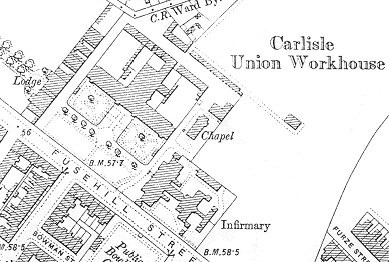
Carlisle workhouse site, 1901.
The building consisted of a long three-storey main block. To its rear was a single-storey dining-hall which originally also served as a chapel.
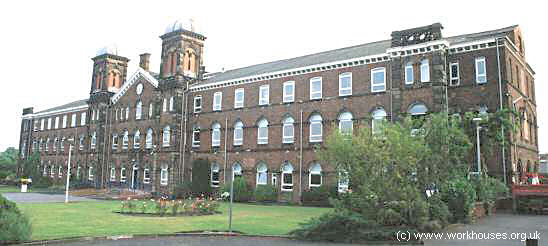
Carlisle main block from the south, 2001.
© Peter Higginbotham.

Carlisle dining-hall and rear of main block from the north, 2001.
© Peter Higginbotham.
The originally entrance to the site was from Union Street (now Broad Street) at the west of the site where the workhouse lodge and reception block were situated.
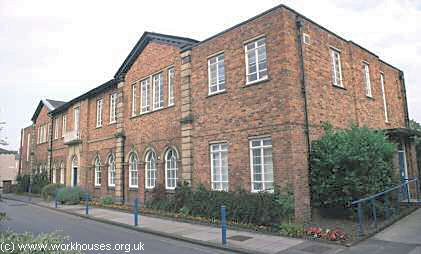
Carlisle reception block from the north-east, 2001.
© Peter Higginbotham.
The workhouse infirmary was located the west of the site.
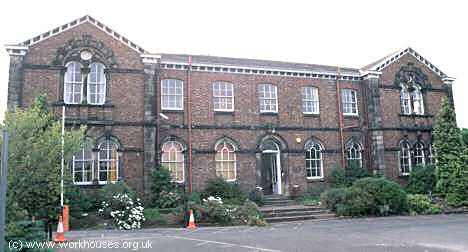
Carlisle infirmary block from the north-west, 2001.
© Peter Higginbotham.
In 1901, a separate chapel was erected to the north of the infirmary.
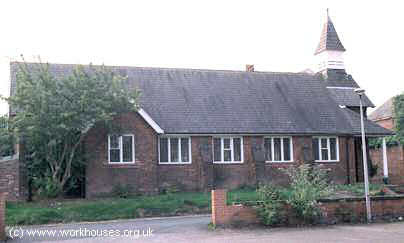
Carlisle chapel from the west, 2001.
© Peter Higginbotham.
From 1904, to protect them from disadvantage in later life, the birth certificates for those born in the workhouse gave its address just as 2 Broad Street, Carlisle.
Fusehill served as a military hospital during both World Wars. During the 1920s was known as Fusehill House Poor Law Institution then in 1930 was renamed Fusehill House Public Assistance Institution. With the introduction of the National Health Service in 1948 it became the City General Hospital, with the former workhouse infirmary becoming the City Maternity Hospital.
Following the closure of the hospital in the 1990s, the refurbished buildings now form the University of Cumbria's Fusehill Campus.
Children's Homes
After the opening of the Fusehill Street workhouse, the former St Cuthert's workhouse was coverted for use as a home for the union's pauper children, known as Harraby Hill House.
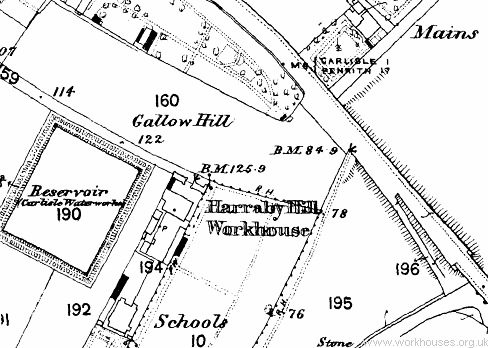
Carlisle Harraby Hill site, 1870.
Boys at Harraby Hill House could join a military-style band.
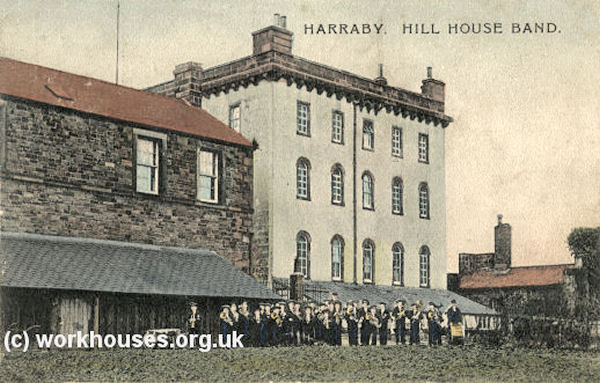
Harraby Hill House boys' band, early 1900s. © Peter Higginbotham.
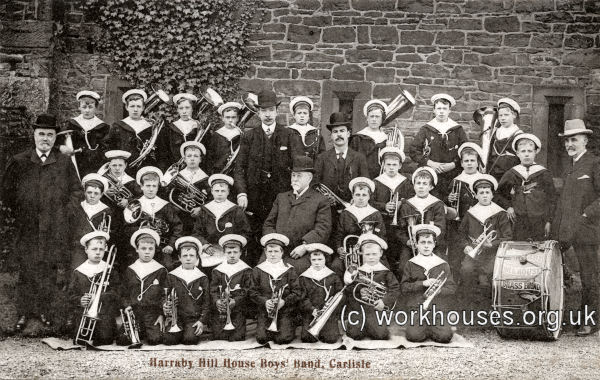
Harraby Hill House boys' band, c.1907. © Peter Higginbotham.
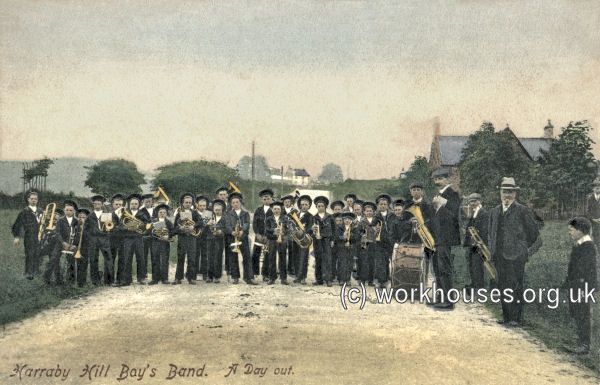
Harraby Hill House boys' band, early 1900s. © Peter Higginbotham.
A British Railways hostel later stood on the Harraby Hill site which is now occupied by a modern hotel.
In 1924, the union established a new children's home in the former West Ward Union's workhouse at Shap.
Staff
Inmates
Records
Note: many repositories impose a closure period of up to 100 years for records identifying individuals. Before travelling a long distance, always check that the records you want to consult will be available.
- Carlisle Archive Centre, Lady Gillford's House, Petteril Bank Road, Carlisle CA1 3AJ. Limited holdings include Guardians' minutes (printed, 1897-1930).
Bibliography
- RN Thompson (1978) The Working of the Poor Law Amendment Act in Cumbria, 1836-1871 in Northern History, Vol XIV.
- Whellan, W (1860) The History and Topography of the Counties of Cumberland and Westmoreland
Links
- None.
Unless otherwise indicated, this page () is copyright Peter Higginbotham. Contents may not be reproduced without permission.


